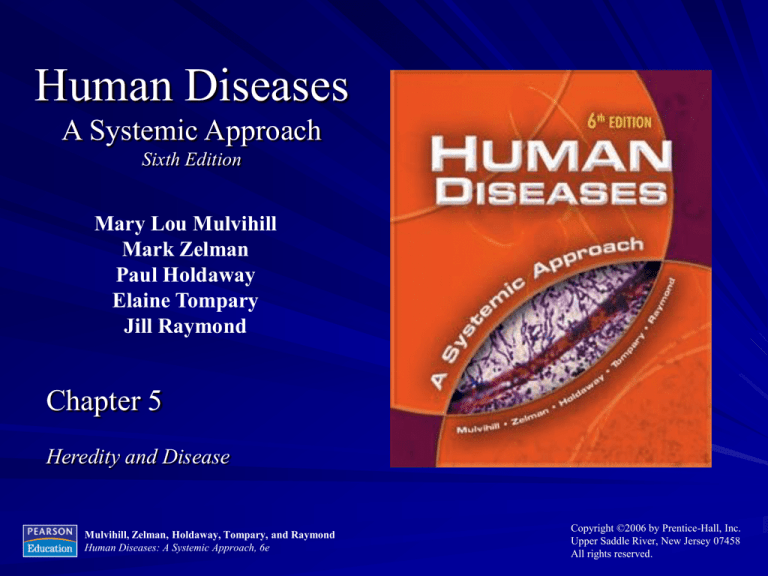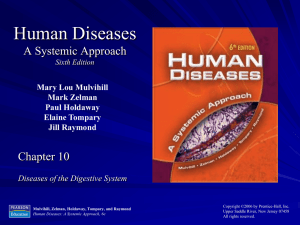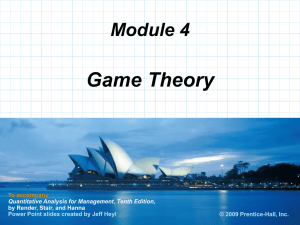
Human Diseases
A Systemic Approach
Sixth Edition
Mary Lou Mulvihill
Mark Zelman
Paul Holdaway
Elaine Tompary
Jill Raymond
Chapter 5
Heredity and Disease
Mulvihill, Zelman, Holdaway, Tompary, and Raymond
Human Diseases: A Systemic Approach, 6e
Copyright ©2006 by Prentice-Hall, Inc.
Upper Saddle River, New Jersey 07458
All rights reserved.
Chapter 5
Heredity and Disease
Multimedia Asset Directory
Slide 10
Slide 24
Sickle Cells
Down Syndrome
Mulvihill, Zelman, Holdaway, Tompary, and Raymond
Human Diseases: A Systemic Approach, 6e
Copyright ©2006 by Prentice-Hall, Inc.
Upper Saddle River, New Jersey 07458
All rights reserved.
Heredity
DNA – blueprint
45 chromosomes (genes) (alleles)
44 autosomes
2 sex chromosomes: X and Y
Karyotype
Mulvihill, Zelman, Holdaway, Tompary, and Raymond
Human Diseases: A Systemic Approach, 6e
Copyright ©2006 by Prentice-Hall, Inc.
Upper Saddle River, New Jersey 07458
All rights reserved.
Genetic Inheritance
Alleles
– Homozygous
– Heterozygous
– Dominant
– Recessive
Mulvihill, Zelman, Holdaway, Tompary, and Raymond
Human Diseases: A Systemic Approach, 6e
Copyright ©2006 by Prentice-Hall, Inc.
Upper Saddle River, New Jersey 07458
All rights reserved.
Figure 5-1: Meiosis.
Mulvihill, Zelman, Holdaway, Tompary, and Raymond
Human Diseases: A Systemic Approach, 6e
Copyright ©2006 by Prentice-Hall, Inc.
Upper Saddle River, New Jersey 07458
All rights reserved.
Figure 5-2: Normal human karyotype.
(©Custom Medical Stock Photo.)
Mulvihill, Zelman, Holdaway, Tompary, and Raymond
Human Diseases: A Systemic Approach, 6e
Copyright ©2006 by Prentice-Hall, Inc.
Upper Saddle River, New Jersey 07458
All rights reserved.
Table 5-1: Hereditary Disease Locations
Mulvihill, Zelman, Holdaway, Tompary, and Raymond
Human Diseases: A Systemic Approach, 6e
Copyright ©2006 by Prentice-Hall, Inc.
Upper Saddle River, New Jersey 07458
All rights reserved.
Autosomal Dominant
Transmission of a dominant allele
50% chance of being affected
Disease appears in every generation
Males and females equally being affected
Mulvihill, Zelman, Holdaway, Tompary, and Raymond
Human Diseases: A Systemic Approach, 6e
Copyright ©2006 by Prentice-Hall, Inc.
Upper Saddle River, New Jersey 07458
All rights reserved.
Figure 5-3: Transmission of autosomal dominant disorders.
(50% chance for an affected child).
Mulvihill, Zelman, Holdaway, Tompary, and Raymond
Human Diseases: A Systemic Approach, 6e
Copyright ©2006 by Prentice-Hall, Inc.
Upper Saddle River, New Jersey 07458
All rights reserved.
Click on the screenshot to view an animation showing
sickle cells.
Mulvihill, Zelman, Holdaway, Tompary, and Raymond
Human Diseases: A Systemic Approach, 6e
Return to Directory
Copyright ©2006 by Prentice-Hall, Inc.
Upper Saddle River, New Jersey 07458
All rights reserved.
Autosomal Dominant Diseases
Polydactyly
Achondroplasia
Marfan’s syndrome
Familial hypercholesterolemia
Mulvihill, Zelman, Holdaway, Tompary, and Raymond
Human Diseases: A Systemic Approach, 6e
Copyright ©2006 by Prentice-Hall, Inc.
Upper Saddle River, New Jersey 07458
All rights reserved.
Figure 5-4: A 12-year old Achondroplastic dwarf. Note the disproportion
of the limbs to the trunk, the curvature of the spine, and the prominent
buttocks.
Mulvihill, Zelman, Holdaway, Tompary, and Raymond
Human Diseases: A Systemic Approach, 6e
Copyright ©2006 by Prentice-Hall, Inc.
Upper Saddle River, New Jersey 07458
All rights reserved.
Autosomal Recessive
Disease manifests when individual is
homozygous for the defective allele
Parents are carriers; they do not have the
disease
Child has a 25% chance of being affected
Recessive allele appears more frequently
in close intermarriages
Mulvihill, Zelman, Holdaway, Tompary, and Raymond
Human Diseases: A Systemic Approach, 6e
Copyright ©2006 by Prentice-Hall, Inc.
Upper Saddle River, New Jersey 07458
All rights reserved.
Figure 5-5: Transmission of recessive disorders (25%
chance for an affected child).
Mulvihill, Zelman, Holdaway, Tompary, and Raymond
Human Diseases: A Systemic Approach, 6e
Copyright ©2006 by Prentice-Hall, Inc.
Upper Saddle River, New Jersey 07458
All rights reserved.
Autosomal Recessive Diseases
Phenylketonuria
Galactosemia
Sickle cell anemia
Tay-Sachs disease
Albinism
Mulvihill, Zelman, Holdaway, Tompary, and Raymond
Human Diseases: A Systemic Approach, 6e
Copyright ©2006 by Prentice-Hall, Inc.
Upper Saddle River, New Jersey 07458
All rights reserved.
Normal red blood cells. (©Phototake NYC.)
Mulvihill, Zelman, Holdaway, Tompary, and Raymond
Human Diseases: A Systemic Approach, 6e
Copyright ©2006 by Prentice-Hall, Inc.
Upper Saddle River, New Jersey 07458
All rights reserved.
Sickle blood cells. (©Photo Researchers, Inc.)
Mulvihill, Zelman, Holdaway, Tompary, and Raymond
Human Diseases: A Systemic Approach, 6e
Copyright ©2006 by Prentice-Hall, Inc.
Upper Saddle River, New Jersey 07458
All rights reserved.
Figure 5-6: Enzyme block in phenylketonuria (PKU)
Mulvihill, Zelman, Holdaway, Tompary, and Raymond
Human Diseases: A Systemic Approach, 6e
Copyright ©2006 by Prentice-Hall, Inc.
Upper Saddle River, New Jersey 07458
All rights reserved.
Sex-Linked Inheritance
Defective gene on X chromosome
Defective X on male is unmasked and the
trait is expressed.
Female is carrier for the disease;
heterozygous
Male transmits the defective allele to his
daughters.
Mulvihill, Zelman, Holdaway, Tompary, and Raymond
Human Diseases: A Systemic Approach, 6e
Copyright ©2006 by Prentice-Hall, Inc.
Upper Saddle River, New Jersey 07458
All rights reserved.
Figure 5-7: Transmission of sex-linked disorders.
Mulvihill, Zelman, Holdaway, Tompary, and Raymond
Human Diseases: A Systemic Approach, 6e
Copyright ©2006 by Prentice-Hall, Inc.
Upper Saddle River, New Jersey 07458
All rights reserved.
Autosomal Recessive Diseases
Color blindness: inability to distinguish
colors
Hemophilia
Fragile X syndrome – a break or
weakness on long arm of X chromosome
Mulvihill, Zelman, Holdaway, Tompary, and Raymond
Human Diseases: A Systemic Approach, 6e
Copyright ©2006 by Prentice-Hall, Inc.
Upper Saddle River, New Jersey 07458
All rights reserved.
Abnormal Chromosome Diseases
Altered number or structure
Failure of chromosome to separate during
cell division
Loss of autosome is usually incompatible
with life
Mulvihill, Zelman, Holdaway, Tompary, and Raymond
Human Diseases: A Systemic Approach, 6e
Copyright ©2006 by Prentice-Hall, Inc.
Upper Saddle River, New Jersey 07458
All rights reserved.
Down Syndrome
Caused by the presence of an extra
autosome, nondisjunction
Results in mental retardation and shorter
life expectancy
Characteristic appearance: slanted eyes,
extra fold of skin at upper medial corner of
the eye, protrusion of the tongue, short
nose
Short stature, underdeveloped sex organs
Mulvihill, Zelman, Holdaway, Tompary, and Raymond
Human Diseases: A Systemic Approach, 6e
Copyright ©2006 by Prentice-Hall, Inc.
Upper Saddle River, New Jersey 07458
All rights reserved.
Click on the screenshot to view a video on the topic of
Down syndrome.
Mulvihill, Zelman, Holdaway, Tompary, and Raymond
Human Diseases: A Systemic Approach, 6e
Return to Directory
Copyright ©2006 by Prentice-Hall, Inc.
Upper Saddle River, New Jersey 07458
All rights reserved.
Figure 5-8: Girl with Down syndrome.
(©Beebe / Custom Medical Stock Photo.)
Mulvihill, Zelman, Holdaway, Tompary, and Raymond
Human Diseases: A Systemic Approach, 6e
Copyright ©2006 by Prentice-Hall, Inc.
Upper Saddle River, New Jersey 07458
All rights reserved.
Familial Disease
Diseases run in families but means of
inheritance are not understood
Most likely the effects of several genes
working together
Examples: diabetes, allergies, familial
polyposis
Mulvihill, Zelman, Holdaway, Tompary, and Raymond
Human Diseases: A Systemic Approach, 6e
Copyright ©2006 by Prentice-Hall, Inc.
Upper Saddle River, New Jersey 07458
All rights reserved.
Cri Du Chat Syndrome
Cat-like cry
Caused by deletion of part of the short arm
of chromosome 5
Results in an abnormally small head with a
deficiency in cerebral brain tissue
Widely spaced eyes and mental
retardation
Mulvihill, Zelman, Holdaway, Tompary, and Raymond
Human Diseases: A Systemic Approach, 6e
Copyright ©2006 by Prentice-Hall, Inc.
Upper Saddle River, New Jersey 07458
All rights reserved.
Sex Anomalies
Turner’s syndrome: missing sex
chromosome
Klinefelter’s syndrome: extra sex
chromosome
Hermaphrodite: has both testes and
ovaries
Pseudohermaphrodite: has either
Mulvihill, Zelman, Holdaway, Tompary, and Raymond
Human Diseases: A Systemic Approach, 6e
Copyright ©2006 by Prentice-Hall, Inc.
Upper Saddle River, New Jersey 07458
All rights reserved.
Figure 5-9: A 21-year-old patient with Turner’s syndrome. The chest is
broad and the nipples are small and pale. Pubic hair is totally lacking.
Mulvihill, Zelman, Holdaway, Tompary, and Raymond
Human Diseases: A Systemic Approach, 6e
Copyright ©2006 by Prentice-Hall, Inc.
Upper Saddle River, New Jersey 07458
All rights reserved.
Figure 5-10: A 19-year-old patient with Klinefelter’s syndrome.
Extremities are excessively long, pubic hair is scanty, and genitals
undeveloped. Body proportions resemble those of a eunuch.
Mulvihill, Zelman, Holdaway, Tompary, and Raymond
Human Diseases: A Systemic Approach, 6e
Copyright ©2006 by Prentice-Hall, Inc.
Upper Saddle River, New Jersey 07458
All rights reserved.
Figure 5-11: A 22-year-old patient with pseudohermaphroditism, reared
as a girl because of ambiguous genitalia. Surgery and tissue studies
showed the gonads to be testes.
Mulvihill, Zelman, Holdaway, Tompary, and Raymond
Human Diseases: A Systemic Approach, 6e
Copyright ©2006 by Prentice-Hall, Inc.
Upper Saddle River, New Jersey 07458
All rights reserved.










